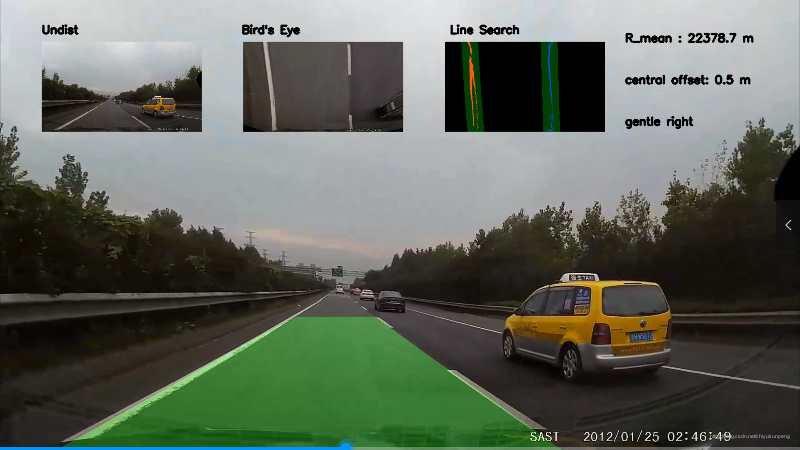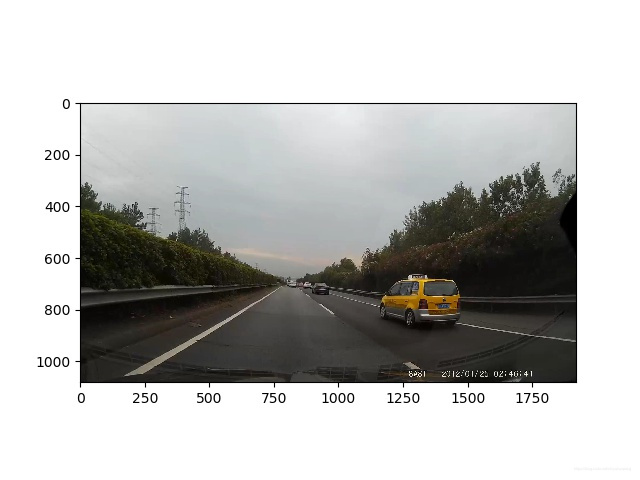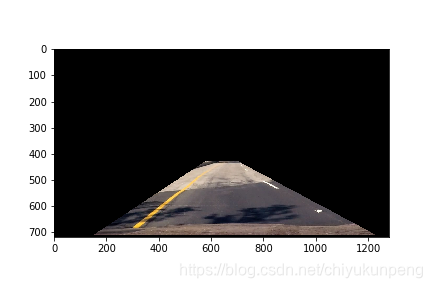传统车道线检测
Advanced_Lane_Detection项目的复现,更换了其中的数据,修改了相应脚本,添加了可视化功能。话不多说,直接上图显示效果。

文章目录
环境要求
- Python 3.5
- Numpy
- OpenCV-Python
- Matplotlib
- Pickle
项目流程
一:相机标定
采用棋盘格对相机进行标定,消除畸变,可采用下列方法(本项目采用第二种)
- 法一:执行calibrate_camera.py脚本获得内参矩阵与畸变系数存入p文件
def calibrate_camera():
# 棋盘格个数及其横纵内角点个数
objp_dict = {
1: (9, 6),
2: (9, 6),
3: (9, 6),
4: (9, 6),
5: (9, 6),
6: (9, 6),
7: (9, 6),
8: (9, 6),
9: (9, 6),
10: (9, 6),
11: (9, 6),
12: (9, 6),
13: (9, 6),
14: (9, 6),
15: (9, 6),
16: (9, 6),
17: (9, 6),
18: (9, 6),
19: (9, 6),
20: (9, 6),
}
objp_list = []
corners_list = []
for k in objp_dict:
nx, ny = objp_dict[k]
objp = np.zeros((nx*ny,3), np.float32)
objp[:,:2] = np.mgrid[0:nx, 0:ny].T.reshape(-1,2)
fname = 'camera_cal/calibration%s.jpg' % str(k)
img = cv2.imread(fname)
gray = cv2.cvtColor(img, cv2.COLOR_BGR2GRAY)
# 棋盘格角点
ret, corners = cv2.findChessboardCorners(gray, (nx, ny), None)
if ret == True:
objp_list.append(objp)
corners_list.append(corners)
else:
print('Warning: ret = %s for %s' % (ret, fname))
# 相机标定
img = cv2.imread('test_images/straight_lines1.jpg')
img_size = (img.shape[1], img.shape[0])
ret, mtx, dist, rvecs, tvecs = cv2.calibrateCamera(objp_list, corners_list, img_size,None,None)
return mtx, dist
- 法二:借助Matlab相机标定工具包,傻瓜式操作得到内参矩阵与畸变系数存入p文件
具体操作请看Matlab相机标定

二:ROI操作
设置mask,只保留车辆前方ROI区域,以便减小二值化处理的难度
def region_of_interest(img, vertices):
mask = np.zeros_like(img)
if len(img.shape) > 2:
channel_count = img.shape[2]
ignore_mask_color = (255,) * channel_count
else:
ignore_mask_color = 255
cv2.fillPoly(mask, vertices, ignore_mask_color)
masked_image = cv2.bitwise_and(img, mask)
return masked_image

三:二值化操作
基于图像的梯度和颜色信息,进行二值化处理,阈值自行调整,初步定位车道线所在位置
# SobelX,SobelY梯度信息
def abs_sobel_thresh(img, orient='x', thresh_min=20, thresh_max=100):
gray = cv2.cvtColor(img, cv2.COLOR_RGB2GRAY)
if orient == 'x':
abs_sobel = np.absolute(cv2.Sobel(gray, cv2.CV_64F, 1, 0))
if orient == 'y':
abs_sobel = np.absolute(cv2.Sobel(gray, cv2.CV_64F, 0, 1))
scaled_sobel = np.uint8(255*ab




 本文介绍了一种基于传统图像处理技术的车道线检测方法,并通过多项式拟合、曲率半径计算等步骤实现了车道线的精准定位及可视化。
本文介绍了一种基于传统图像处理技术的车道线检测方法,并通过多项式拟合、曲率半径计算等步骤实现了车道线的精准定位及可视化。
 最低0.47元/天 解锁文章
最低0.47元/天 解锁文章

















 被折叠的 条评论
为什么被折叠?
被折叠的 条评论
为什么被折叠?








